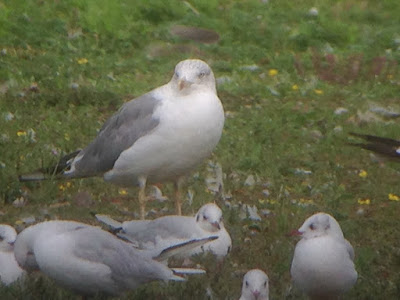September 6th - this was my first day since mid July when I could devote some proper time to birding the patch as both children had returned to school. I had a plan - I was still missing Redstart, Whinchat and Spotted Flycatcher for the year. Time was passing, but this is still a good date to pick these species up, so I intended to cover those areas of the patch that had been neglected in order to maximise my opportunities.
I started at the lake, not a good place for at least two of the three, but it was overcast and muggy so it's always worth checking for passing waders or terns. Actually, since my last post, the single juvenile
Black Tern has stayed throughout, this being its 10th day on site, emulating a juvenile bird that stayed for a fortnight back in September 2013. A juvenile
Dunlin also turned up on the 1st and was still present for its 6th day this morning. A probable Pec Sand was reported from this site on the day the Dunlin turned up, by observers unknown - I am hoping that this was a case of mistaken identity rather than a mega gone missing. It was checked out an hour or two after the report surfaced but only the Dunlin was present.
A couple of Common Sands were still bobbing around, there have been up to three recently, and the regular adult Yellow-legged Gull was also present. A small influx of Teal, nine birds, a couple of Shoveler and a small group of four Pochard were the only slightly interesting water fowl.
Having checked out the lake, I decided to do a circuit, taking in the riverside meadows, the often productive railway bank and making my way to the northern fields and hedgerows. The first of these drew a blank, however, the northern area looks quite interesting at the moment since the removal of the poplars last year. There has been a small amount of regeneration and birds are more obvious here than they used to be. I spent a while scanning a hedge line that separates the two fields, as there were a few birds moving around amongst the thick vegetation. There were a lot of Robins, but I picked out a couple of juvenile Whitethroats, possibly a sign of successful breeding. I eventually made my way along the path and passed through the end of the hedge, as I did so, a bird flew from right next to me and followed the hedge northwards. I got it in my bins as it flew and was confronted with a brownish bird with a bright rusty red tail with darker central tail feathers - a
Redstart! I watched it fly into the hedge, noted its position and carried on along the path to get a better viewing angle. As I did this, I sent out news, as this is a rare bird around the lake itself and I knew that Alan S needed it for a patch tick. He was on his way. I continued to watch the area of thick hedge where it flew in, but after a while had had no further views. I retraced my steps to watch the other side of the hedge and still got nothing further. Alan had arrived by this point, so I met up with him and we both continued to watch - still nothing. I retraced my steps again so that we were watching one side of the hedge each - still nothing. After more than an hour, I gave up and left Alan to it. He gave it 2 hours and drew a blank. Who knows what happened to it, but I was happy with the year tick and one of my quarry down.
Next, I walked along the track to the athletics track, as this is where I have had Whinchat in the last couple of years. Nothing of note today. Then I visited Emmett's farm, which I hadn't been to in several months. The area just by the last farm buildings was most productive. I could hear lots of twittering Linnets together with
Yellow Wagtail calls as I walked up. The Linnets were feeding on low seed heads and also using a small puddle to drink and bathe. When they flew up in a flock, they numbered around 200 birds, so have obviously had a great breeding season. The Yellow Wagtails were sort of with the Linnets, though they kept flying up to the guttering of the last barn as there was a small stretch that had retained rain water, which they were using much as the Linnets were using the puddle. I counted four birds and also rather a smart moulting
White Wagtail with them. A record of one of the birds is below:
Next stop was Pump Lane paddocks, which has been the best site over the years for both Wheatear and Whinchat, though I actually drew a blank with Whinchat here last year. After a while scanning all the fence lines over what is quite a large site, I eventually picked up a small blob on a very distant fence to the north of the site which looked quite promising. I set the scope up and was soon enjoying a
Whinchat, so a further success with my plan. The poor record shot below is a result of the vast distance the photo was taken from, but is just about recognisable.
There was a further large flock of Linnets at this site too, around 100 birds. 300 Linnets on patch brings a smile to my face.
So that was that for my birding outing, very enjoyable and very successful, with two out of three target birds found, Spot Fly next!



















































